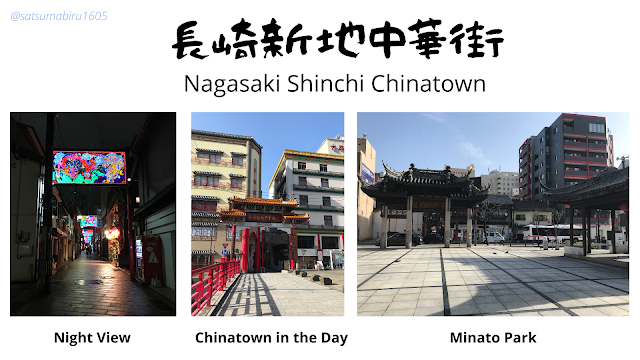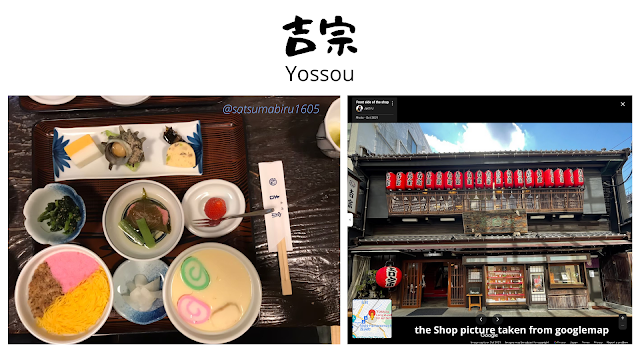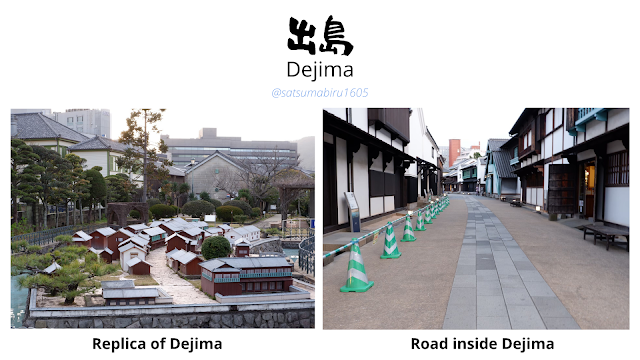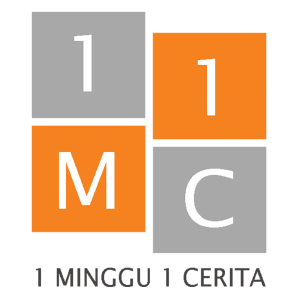The whole trip was originally arranged by my Japanese friend after I complained that our graduation ceremony is cancelled due to Covid-19 prevention. I felt that the last one month of my stay in Kagoshima is just wasting my time but couldn't do anything because my home return flight ticket was booked in the end of March by MEXT. Celebrating graduation trip using public transportation is still worrying so that she made a trip plan to Nagasaki and Saga which she drive the car by herself.
After visiting Shimabara and Unzen City on the first day, we went to Nagasaki Shinchi Chinatown and stayed for a night in Dormy Inn Nagasaki. The hotel building is just in front of Shinchi Chinatown Bridge which is famous for tourist attraction. I have plenty time to walk around Chinatown in the night and early in the morning. This place usually attracts a lot of people that become so quiet as the effect of pandemic. Some restaurants still open in normal working hours.
Dinner in Kaniya: Onigiri Special Outlet
Since my friend know that I eat only halal food, she picked Onigiri special outlet so that I can choose by myself what I can eat. Here we can order by custom. There are so many types of onigiri, i.e. seaweed (nori), ume boshi (plum), tuna katsuo, etc; many Soups, i.e. Goto Udon, Miso Soup, Shell Soup, etc; Ochazuke; drink; and common menu. The price quite cheap and you pay what you eat, so we can order more if we still want to eat. My favorite menu is Konbu Oden, it was so delicious that I ordered many times. The menu and price can be accessed in Kaniya website.
Nagasaki Peace Park
This is an open area that we can visit anytime. We went there using tram from Shinchi Chinatown tram station to Peace Park tram station which cost only 130 Yen (in March 2021). After crossing the street from the tram station, there is stairway or we can choose elevator in the right side. The Peace Fountain is the gate that lead to the Peace Park walking area.
In the Peace Fountain stone written a poem that means "I was thirsty beyond my capacity. The water is so oily, but I wanted so badly so I drank it". It was sad message from SachikoYamaguchi, a nine years old girl at the time of bombing. Many peace symbols was donated from countries around the world docorated along the way to Peace Statue as the end mark of this park.
The Peace Statue was designed by Seibo Kitamura to memorize the people in Nagasaki who died during atomic bombing in 9 August, 1945. There are a lot of crane origami hanging surround the Peace Statue donated from visiting schoolchildren and the elderly as symbols of peace.
In the old Japanese legend, anyone who makes Senbazuru(千羽鶴)that literally means 1000-crane origami held together by strings, will be granted a wish by the gods such as happy life, wealth, or cured from the illness, etc makes it popular to give senbazuru as a gift so special friend or family.
More information about Peace Park can be accessed in Nagasaki Peace website.
Hypocenter Park
Walked to the southern part of Peace Park, there is a Hypocenter Park located. The Hypocenter Cenotaph is the exact area location below where atomic bomb exploded in the air. There also stand the wall remained from Urakami Cathedral (half of the wall is relocated to the Atomic Bomb Museum) after bombing. The Urakami Cathedral itself rebuilt in the new location around 500 m from the hypocenter site.
The stone lanterns which remained standing at Shotokuji Temple (1.5 km from hypocenter) after explosion, then these lanterns was donated and relocated to this park. The ground level at the time of bombing is left as it is and stored in glass so that visitors can still see the actual conditions of soil surface appearance when the bomb exploded.
A lot of trees grow here and sakura also blooming when I visited this place on March 2021. Kindergarten students playing around with their teachers in this park. With todays situation, no one ever imagine that around 70s years ago this place was devastated by atomic bomb explosion.
Atomic Bomb Museum
Its not far from the Hypocenter Park, we can just walking to visit Atomic Bomb Museum. The admission fee is 200 Yen for adult and they will give us guide brochure which available in many language. Taking picture is allowed inside the museum, but I felt a little bit inconvenient for taking so often.
Once we enter the museum, we will welcomed by the sentence of hope that "Nagasaki supposed to be the last place exposed by atomic bomb" as well as unforgettable memories after explosion. Half part of wall remains from Urakami Cathedral is relocated here assembled with other memorable stuff such as kindergarten bicycle which was buried with the child after explosion, students bento box, helmet, etc. Each stuff has their own sad story behind so then donated to this museum.
The atomic bomb structure and the explosion effect is clearly explained in this museum. The explosion effect caused by radiation to the environment and human disease years after explosion also discussed which remind us how disastrous it was. The living witness of atomic bomb testimony also documented in video. And the last part of this museum is about peace movement in Nagasaki itself and also in the world.
This museum explained detail about atomic bomb and world war II which Japan take the part in it. Most of information translated in English, Chinese and Korean, so don't worry if you don't understand Japanese.
Lunch in Yossou Washoku Restaurant
This classic Japanese restaurant offer various menu which ranging from 1500 - 7000 Yen. The choices are sets of chawanmushi, makunouchi, teishoku, sushi, and single dish. The menu can be checked in their Yossou website that available in English version.
Because I like chawanmushi, so I choosed chawanmushi set which consist of conger eel, shrimp, chicken, shiitake mushrooms, wood ear mushrooms, ginkgo nuts, bamboo shoots, kamaboko, etc. It was big size and delicious meal.
Meganebashi Bridge
It's called meganebashi, literally means spectacles bridge, because it's look like a pair of spectacles when reflected to the water. Meganebashi is one of the old stone bridge in Japan built over Nakashima river by Chinese monk living in Kofukuji temple. Today, only pedestrian allowed to cross over this bridge.
Near Meganebashi, there is a confectionary that sell Chinese snacks like Yori-yori and also some souvenirs.
Oura Church
Oura is one of several churches built after the crucified Twenty-six Martyrs of Japan. It is said to be the oldest church in Japan that was also the first Western-style building in Japan designated as National Treasure.
I did not enter this church due to time limitation of my visit in Nagasaki City, but if you are interested in the history of missionaries and merchants from Portuguese and Spain, as well as the crucified of Christian in Japan, you may get a lot of information by visiting this church. The entrance admission is 1000 Yen for adult.
Glover Garden
A few step ahead from Oura Church, the Glover Garden is located. In this garden, there is a residence of Thomas B. Glover, a businessman that hugely contributed to the modernization of Japan. Glover garden that offers beautiful scenery from Nagasaki port was donated by Nagasaki Shipyard of Mitsubishi Heavy Industries to Nagasaki City and be opened for public.
The admission fee is 610 Yen for adult. More information can be accessed in website of Glover Garden.
Dejima
My friend suggested to visit this place as the last destination because of the operating hours is longer than any tourist area (from 10.00 to 21.00). The location is just 10 minutes walk from Shinchi Chinatown. The admission fee is 520 Yen for adult, then visitor can get pamphlet and a lot of information by strolling around.
Dejima, literally means exit island, is an human artificial island in Nagasaki port aimed to control missionaries activity of Portuguese from Japanese. After Portuguese was expelled, Dejima become the center of Dutch East India Company (Vereenigde Oostindische Compagnie - VOC). In current Dejima, all of the past activities from East Asia is explained, including the sugar supply chain from Indonesia to Japan.
More information about can be accessed in Nagasaki Dejima.
I did my dinner in Chinatown again before continue the trip to Saga Perfecture.
You may interested to read articles below:
- Menjelajahi Kota Nagasaki dalam Sehari
- Perlu Diketahui Sebelum ke Kota Nagasaki
















2 comments
Found your story from bloggerperempuan.com. Nice story and so well written. Maybe I will try to write my stories in English too even though I am not that fluent. lol. Keep writing!!! If you don't mind you can visit my blog
ReplyDeletein dailyofcita.blogspot.com. Thank you^^
Hello mbak, thanks for visit ;))
DeleteThanks for leaving your comments